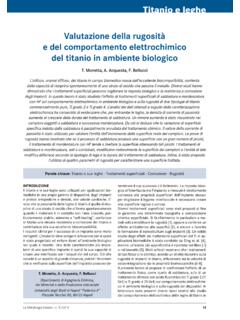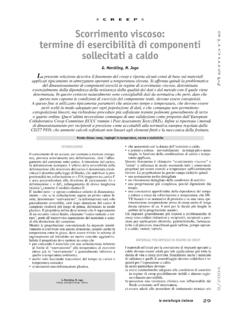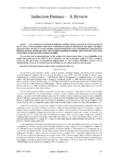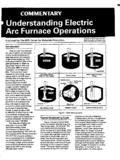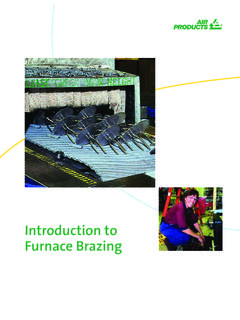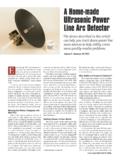Transcription of PROCESSI The EAF technology evolution and the …
1 PROCESSI1/2005 Memoriela metallurgia italiana41 The EAF technology evolution and the Consteel systemP. Argenta, M. Bianchi FerriDuring the past 11 years, steel production by the electric arc furnace route (EAF) has grown on a worldwide basis by , while the total steel production has grown by scope of this paper is to illustrate the benefits of steel production through the Electric Arc Furnaceroute, such as the lower investment costs, higher production flexibility and lower environmental impact,and the latest developments of the EAF based melt shops with the continuous scrap charging and pre-heating completed by hot metal words.
2 Steel, hot metal, steel making, environment, energyCURRENT SITUATIONAs stated in the Foreword, during the past 11 years the steelproduction by the electric arc furnace route has grown on aworldwide basis by while the total steel produc-tion has grown by Nowadays, EAF steel (330 million tons) of all the steel produced in theworld, whilst 11 years ago this figure was 30% ( ).Between 1992 and 2002, the increase in the proportion ofEAF steel has been remarkable in Nafta, Europe and South-East Asia whilst in the former Soviet Union it has , inside the worldwide picture, is to focus on Chi-na, the most growing country.
3 Although in 2002 the produc-tion of steel through the EAF route has doubled compared tothat of ten years ago, the proportion of EAF based steel hasdeclined due to the fact that BF-BOF technology (Blast Fur-nace Blast Oxygen furnace ) has dominated the scene fornewly installed the first time since 1992, in 2003 the percentage of EAFsteel production is raised, reaching 20%.The growth of EAF steel production in Western countries aswell as in South East Asia, is justified by the following ad-vantages of EAF technology : lower investment cost, higheroperational flexibility and reduced environmental impactThis growth has been obtained by updating the installationsand technologies; this target has been achieved not only byincreasing furnace capacity and power consistent with theavailable electrical systems and networks, but also by im-proving their productivity through the optimisation of thechemical process.
4 Table 1 shows how the main features of the EAF, particu-larly the furnace capacity and the transformer power, haveevolved in highly industrialized countries between 1990 far as China is concerned, in the year 2000 there werePaolo Argenta, Mauro Bianchi FerriTechint Technologies, Milano (Italy)Paper presented at the 2ndInternational Conferenceon New Developments in Metallurgical Process technology , Riva del Garda, 19-21 September 2005, organised by AIMFig. 1 World Production ofCrude Steel and % of 1 Produzione mondialedi acciaio grezzo epercentuale di acciaioprodotto con (Europe + USA + Japan)19901999% increaseFurnace Capacity (Ton / heat)8611028 %Transformer Power (MVA)608033 % furnace Productivity (Ton / hour)619454 %Table 1 evolution of the main features of the EAF in highly industrialized countries between 1990 1 Evoluzione delle principali caratteristiche dell EAF nei paesi altamente industrializzati tra il1990 e il metallurgia italiana42 THE CONSTEEL SYSTEMThe Consteel system (Figure 4)
5 Performs the continuouscharging of scrap in the EAF by means of a conveying sy-stem that connects the scrap yard to the the Consteel system, scrap is loaded onto conveyorsby the scrap yard cranes. Then the conveyors move theFig. 2 Production of CrudeSteel and % of EAF Steel inNAFTA, Europe, South EastAsia, former Soviet Union(CIS).Fig. 2 Produzione mondialedi acciaio grezzo e percentualedi acciaio prodotto con EAFin NAFTA, Europa, Sud EstAsia, Unione sovietica (CIS).Fig. 3 Production of CrudeSteel and % of EAF Steel 3 Produzione mondialedi acciaio grezzo e percentualedi acciaio prodotto con EAFin than 130 Electric Arc Furnaces in operation with anestimated average productivity of 35 ton/hour and an esti-mated average capacity of 30 ton/heat.
6 This figure is rapidlygrowing, since the average capacity of new furnaces instal-led between the year 2000 and the year 2003 is nearly 60 the table above it can be concluded that the producti-vity of these electric furnaces has grown nearly twice as mu-ch as the furnace capacity and transformer power. This hasbeen the result not only of improvements in the operatingprocedures, but also of the massive utilisation of the chemi-cal package. In fact, between 1998 and 2003 there were more than 180installations of new carbon-oxygen lances worldwide. Outof these 180 installations, 60% was concentrated in WesternEurope and North America whilst less than 10% was con-centrated in latest developments in EAF steelmaking, with extensi-ve use of DRI, HBI and hot metal as raw materials, are lea-ding towards the installation of EAF steel plants in locationsand for applications (high quality flat steels, special grades),previously unforeseen and more typical of BF-BOF steel-making.
7 These developments will also contribute to the futuregrowth of EAF 4 Consteel 4 Il sistema Consteel .PROCESSI1/2005 Memoriela metallurgia italiana43scrap, and the conveying surface oscillates forward slowlyand backward faster. This movement allows the scrap to mo-ve together with the conveyor during the forward stroke,while the scrap slides over the surface when the conveyoroscillates back. The end result is the movement of the scraptowards the reaching the furnace the scrap enters the preheating sec-tion, in this area the scrap is heated-up by the hot gases exitingthe EAF that are moving in the direction opposite to the the preheating section the carbon monoxide in the exhau-st gas is oxidized by an automatically controlled injection ofair, allowing more energy to be recovered by the the continuous feeding operations the steel bath inthe EAF is kept constantly liquid and the scrap entering thefurnace is melted by immersion.
8 The electric arc is workingon a liquid bath, not on solid scrap. In this situation the arc isstable and it is not affected by the presence of solids like inthe case of batch charges (with or without preheating).Currently the Consteel system is in operation in sixteenmelt shops (in start-up order): Ameristeel (Charlotte, USA),Nucor (Darlington, USA), Kyoei (Nagoya, Japan), CoSteel(Sayreville, USA), NSM (Bowin, Thailand), ORI Martin(Brescia, Italy), Xining (China), Guiyang (China), Ameri-steel (Knoxville, USA), Nucor (Hertford, USA), Shaoguan(China), Wuxi (China), Shiheng (China), E cheng (China),Tonghua (China) and Wheeling Pitt (USA).
9 Three new plants are under design/construction phase, na-mely: Hengly in China, Jiaxing in China and Sonasid in are two main characteristics that make the Consteel system different from most of the other technologies availa-ble for melting scrap in the EAF: the preheating and the con-tinuous preheating is important to save energy, but the conti-nuous charging has shown more benefits for the users interms of: Fast payback Low production costs High productivity Flexibility Reduced environmental impact Personnel Charge PreheatingPreheating the charge is very helpful to reduce the energyconsumption of the 5 shows the energy savings (in kWh/t) that can beobtained as a function of the preheating temperature and themelting an average preheating temperature between 400and 600 degrees Centigrade and an overall melting effi-ciency between 70 and 80%, we read energy savingsFig.
10 5 Scrap preheating 5 Gli effetti del riscaldamento del 6 Consteel heat 6 Ciclo di colata del Consteel .between 80 and 120 kWh per ton of liquid steel tapped. The-se values are confirmed by the experience from existingConsteel Continuous ChargingCharging continuously means to distribute the scrap chargealong the whole power-on period. The buckets are not used,and the conveyor feeds the scrap from the yard directly intothe EAF. The EAF roof is always closed and the gas suctionis constantly performed from the primary circuit, not by thecanopies of the secondary circuit. In the furnace the scrapmelts by immersion and the electric arc is working on flatbath covered by the foamy EAF control system adjusts automatically the con-veying speed to maintain the steel bath at the target tempera-ture and controls the oxygen and carbon injection to main-tain the proper foamy 6 shows the typical working diagram for an EAFequipped with the Consteel characteristics give the Consteel substantial advan-tages in terms of operational savings and environmental im-pact reductions.
